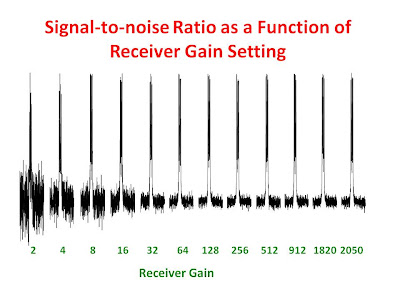One of the first pulse sequences typically introduced in NMR textbooks is the spin echo or Hahn echo. This sequence consists of a 90° pulse followed by a delay, τ, during which offsets frequencies evolve. A 180° pulse is then applied after which another period of time, τ is allowed where offsets continue to evolve, producing an echo at 2τ. The spin echo sequence has the ability to refocus the distribution of offset frequencies due to magnetic field inhomogeneity (inhomogeneous broadening) however it cannot refocus the natural distribution of frequencies due to the T2 relaxation process (homogeneous broadening). It would seem as if the spin echo sequence has the ability to separate out the homogeneous broadening from the inhomogeneous broadening and therefore should be able to be used to measure the T2 relaxation time constant in a scheme like the one shown in the figure below.
where the intensity of the signals as a function of 2τ is fitted to an exponential decay to give T2. Can this sequence really be used to measure T2? Let's look a bit deeper.
A sample of tetrakis-trimethylsilyl silane ( Si(Si(CH3)3)4 ) was dissolved in CDCl3. The magnet was shimmed such that the full line width at half height of the 1H resonance was 2 Hz. A standard one-pulse proton spectrum and a Hahn echo spectrum (with τ set to 1 second) were collected. The same measurements were made after adjusting the magnetic field shims such that the full width at half height was 5 Hz and 13 Hz. The results are shown in the figure below.
The top panel shows the NMR spectra resulting from the one-pulse measurement. The spectra all have the same integrated area as expected. The middle panel shows the FID's from the one-pulse measurements. The initial intensity of each FID is the same since the initial intensity of the FID is proportional to the integrated area of the resonance in the frequency domain. The bottom panel shows the Hahn echoes collected with a value of τ =1 second (a value substantially shorter than T2). The receiver was turned on immediately after the 180° pulse to collect the entire echo. Unlike the one-pulse FID's which remained constant as a function of magnetic field inhomogeneity, the height of the Hahn echoes decreased as the magnetic field inhomogeneity increased, all other parameters being constant. This should convince you that the simple Hahn echo is not always suitable for T2 measurements as the intensity of the echo depends on the degree of inhomogeneous broadening. This is so because of molecular diffusion. During the one second τ delays, molecules move from one volume element to another in the sample and therefore change their offset frequencies over the course of the measurement. The net result for the entire sample leads a loss in echo intensity due to destructive interference in the time domain signal from the sum of all volume elements. The loss in echo intensity is worse the more inhomogeneous the field. The simple Hahn echo would be expected to work as a means to measure T2 only in cases where the diffusion is insignificant with respect to τ (solids or dissolved macromolecules).
How then are T2's measured for small molecules in solution where diffusion is fast? One uses a train of Hahn echoes where the τ delays for each echo are chosen sufficiently short such that diffusion is not a problem (typically on the order of msec or tens of msec). The T2 is calculated from a series of spectra collected as a function of the number of echoes in the train based on the overall time between the initial 90° pulse and the collection of the signal. Such a scheme is called a Carr Purcell Meiboom Gill (CPMG) sequence and is shown in the figure below.



















